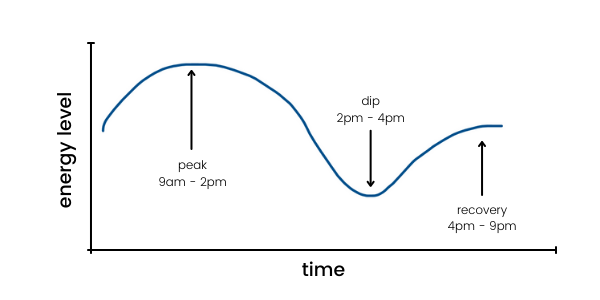
Disclaimer: I am not a scientist, doctor, or sleep expert, just a 31-year-old freelancing graduate student juggling multiple projects every day.
In 2019 I attended a Digital Summit in Denver, and besides the deluge of non-prescription blue light blocking glasses (I’m wearing some right now), I most remember a keynote speech on understanding your circadian rhythm and its effects on productivity throughout the workday. This was profound to me for a couple of reasons. One, I naively assumed that we all had the same work rhythms throughout the day and collectively reached for that post-lunch, afternoon-slump coffee. And two, it had never dawned on me to understand my energy level patterns and align them with my work. This concept opened up a new world of understanding myself, when I feel most focused or foggy, and how to leverage this knowledge for daily success. It also helped me better understand my colleagues and how to improve collaboration throughout our standard 9-to-5 day.
We don’t necessarily have a prescribed 9-to-5 schedule as freelancers, so why should this concept matter to us? While we might have routines, our days are flexible and understanding your natural daily energy levels will help you better plan your day based on what requires your attention.
What exactly is chronotype?
Your natural daily energy levels, when you feel alert or groggy, are affected by your chronotype. Whereas circadian rhythm is your daily sleep-wake cycle, which can be more or less trained or manipulated, chronotype is your natural inclination towards sleep and wake times. Chronotype is considered more permanent, potentially genetic, and responsible for why we categorize people as “early birds” or “night owls.” Essentially, it’s your default sleep and wake times. If you didn’t set your alarm in the morning, what time would you naturally wake up?



There are three general overarching chronotypes: AM-Shifted, Bi-Phasic, and PM-Shifted. Relatively self-explanatory, we associate AM-Shifted with early birds and PM-Shifted with night owls. Approximately 15-20 percent of the population are in each category, and the remaining 60-70 percent of the population land right in the middle as Bi-Phasic. For instance, I’m not an early bird or a night owl; I’m your standard day pigeon that can evolve into a night owl if a really good docuseries is involved.
Intuitively you probably know which of the three chronotypes you belong to, but there are several online resources and tests that will reveal your unique chronotype and also any associated idiosyncrasies. I took an assessment by my chronotype, and was rewarded with a thorough report on my chronotype energy curve and recommended strategies to mitigate the dips and optimize my daily workflow.
I know what you’re thinking: “I already know my enneagram number, my personality trait, the color of my parachute, my zodiac sign, and Hogwarts House. I don’t need another categorization.”
I get it, but stick with me! Let’s look at how leveraging this information as freelancers can help make every day more successful.
Understanding and leveraging your chronotype for success
Have you ever started a project in the afternoon, hit a wall pretty quick, only to pick it up the following morning with ease? Or vice versa? It turns out chronotype plays an enormous role in this phenomenon. Each chronotype has essentially three stages of the day: a peak, a dip, and a recovery. For AM-Shifted and Bi-Phasic groups, these stages happen earlier than PM-Shifted rhythms, but it might look like this:

Each stage of your day has task types that best align with your energy level. For example, it’s best to work on projects that require the most analysis and focus at your peak. These are the tasks that take the most brainpower. For me, that’s research, writing, data analytics, and reporting - basically anything that requires my brain to be firing on all cylinders. Remember, if you’re PM-Shifted, you might not hit your peak until later in the afternoon or evening!
I dip, you dip, we dip at different times depending on chronotype. Whenever you experience your daily dip is the perfect time to do some administrative tasks that don’t require complex brain functions, such as sending emails. Or, because we’re freelancers, it’s the perfect time to go for a walk or take a break (*cough-nap-cough*). This may not be the best time to make an important decision or schedule an important meeting.
Lastly, your recovery zone is the best time to handle non-systematic tasks and creative work. An example could be brainstorming or producing graphics, any open-ended activity. For my marketing business, this is the best time for me to visualize email layouts and graphics and not the best time to write copy.
Out of necessity, tasks may need to be completed outside of the optimum performance window, and we certainly know this to be accurate as freelancers (can I get an amen?). Instead, if you can, work with your biological rhythms and not against them. Understanding your natural peaks and dips throughout the day helps optimize your workflow for more productive and successful outcomes.
Sources:
My Chronotype
Sleep Foundation
Psychology Today
National Institute of General Medical Sciences
